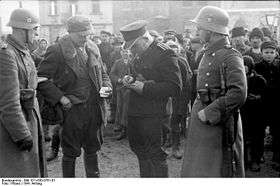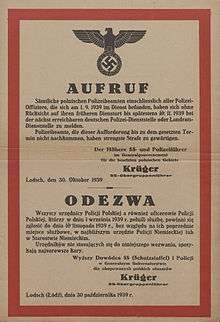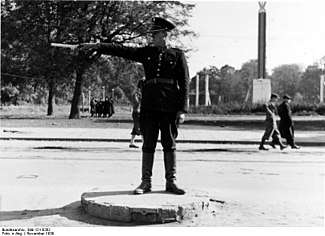Blue Police
| The Blue Police | |
|---|---|
| Polnische Polizei im Generalgouvernement [1] | |
 Police street check in Kraków overseen by German Order Police | |
| Active | October 30, 1939 – August 27, 1944 |
| Country | General Government territory of Nazi Germany |
| Role | Auxiliary police |
| Commanders | |
| Colonel of the Regiment | Major Hans Köchlner (until 1942) |
| Notable commanders | Aleksander Reszczyński (AK) |
The Blue Police (more precisely, Navy-Blue Police, Polish: Granatowa policja) was the Polish police during the Second World War in German-occupied Poland (the General Government). The entity's official German name was Polnische Polizei im Generalgouvernement (Polish Police of the General Government; in Polish: Policja Polska Generalnego Gubernatorstwa).
The Blue Police officially came into being on 30 October 1939 when Germany reinstated Poland's prewar state police (Policja Państwowa), with German leadership replacing Polish.[1] It was an auxiliary institution tasked with protecting public safety and order in the General Government.[2] Similar police forces, based on local professional police, existed in all German-occupied European countries. The Blue Police, initially employed purely to deal with ordinary criminality, was later also used to counter smuggling, which was an essential element of German-occupied Poland's underground economy.[1]
The organization was officially dissolved and declared disbanded by the Polish Committee of National Liberation on August 27, 1944.[3][4] After a review process, a number of its former members joined the new national policing structure, the Milicja Obywatelska (Citizens' Militia). Others were persecuted after 1949 under Stalinism.[5]
Organization

In October 1939, General Governor Hans Frank ordered the mobilization of the pre-war Polish police into the service of the German authorities. The policemen were to report for duty or face the death penalty.[6] Formally, the Polnische Polizei (PP) was subordinate to the German Order Police (Uniformed Police, Orpo). The same prewar facilities were used across occupied Poland with exactly the same organizational structure, under Major Hans Köchlner (he was trained in Poland in 1937).[1] They wore the same uniforms, but without national insignia. In spring 1940, the Ukrainian Police was split off from the Polish Police. The department existed already before 1939. The German chief of the Order Police (KdO, as well as its entire leadership) assumed dual role, in charge of both.[1] After the attack on the USSR known as Operation Barbarossa, all newly acquired territories in the District of Galicia were put under the Ukrainian control with headquarters in Chełm Lubelski.[1] Notably, the District of Galicia created on August 1, 1941 (Document No. 1997-PS of July 17, 1941 by Adolf Hitler) – although considered by some to be part of the occupied Ukraine – was a separate administrative unit from the actual Reichskommissariat Ukraine created on September 1 of the same year. They were not connected with each other politically.[7]
According to historian Andrzej Paczkowski (Spring Will Be Ours), the police force consisted of approximately 11,000–12,000 officers,[8] but the actual number of its cadre was much lower initially.[8][9] Emmanuel Ringelblum put the number as high as 14,300 by the end of 1942 including Warsaw, Lublin, Kielce and Eastern Galicia.[10] The Encyclopedia of the Holocaust reports its manpower as 8,700 in February 1940 and states that it reached its peak in 1943 with 16,000 members.[11] The statistics are explained by historian Marek Getter.[1] The initial expansion of the force was the result of expulsion to Generalgouvernement of all Polish professional policemen, from the territories annexed by the Third Reich (Reichsgau Wartheland, Westpreußen, etc.). Another reason was a salary (250–350 zł) impossible to obtain elsewhere, augmented by bonuses (up to 500 zł each). Also, the Germans had intentionally eroded moral standards of the force by giving policemen the right to keep for themselves 10% of all confiscated goods.[1] The Blue Police consisted primarily of Poles and Polish speaking Ukrainians from the eastern parts of the General Government.[12] However, from August 1, 1941 (date of incorporation) the district of Eastern Galicia – as mentioned by Ringelblum – was no longer controlled by the ethnically Polish division of PP. Instead, the Ukrainian division was put in charge across some 600 precincts, expanded from 242 officers initially, to 2,000 by 1942, and to 4,000 officers by 1943.[1]


The Blue Police had little autonomy, and all of its high-ranking officers came from the ranks of the German police (Kriminalpolizei). It served in the capacity of an auxiliary force, along with the police forces guarding seats of administration (Schutzpolizei), Railway Police (Bahnschutz), Forest Police (Forstschutz) and Border Police (Grenzschutz).[13] The Blue Police was subordinate to the German Order Police with Polish prewar regulations.[14] New volunteers (Anwärter) were trained at a police school in Nowy Sącz, with 3,000 graduates (receiving salary of 180 zł each), under the Schutzpolizei Major Vincenz Edler von Strohe (real name Wincenty Słoma, a Reichdeutscher formerly in the Austrian police).[p. 7] There were additional though separate courses for Polish and Ukrainian enlisted ranks.[1]
From the German perspective, the primary role of the Blue Police was to maintain law and order on the territories of occupied Poland, as to free the German Order Police for other duties. As Heinrich Himmler stated in his order from 5 May 1940: "providing general police service in the General Government is the role of the Polish police. German police will intervene only if it is required by the German interests and will monitor the Polish police."[14]
As the force was primarily a continuation of the prewar Polish police force, it also relied largely on prewar Polish criminal laws, a situation that was accepted as a provisional necessity by the Germans.[12] While the Polish Underground State had its own police force and judiciary (see National Security Corps and Directorate of Civil Resistance), it was unable to provide basic police services for the entire population of the former Second Polish Republic in the conditions of German occupation.
Historical assessment

The role of the Blue Police in its collaboration and resistance towards the Germans is difficult to assess as a whole, and is often a matter of dispute.[15] Historian Andrzej Krzysztof Kunert estimates that 10 to 20% of the policemen were murdered by the Germans for taking part in resistance – on top of those mass-murdered by the Soviets in Mednoye – explained Irena Wollen in her documentary film "Granatowi" for Telewizja Polska (1999).[5]
Scholars disagree about the degree of involvement of the Blue Police in the rounding up of Jews.[16][17] Although policing inside the Warsaw Ghetto was a responsibility of the Jewish Ghetto Police, a Polish-Jewish historian Emmanuel Ringelblum, chronicler of the Warsaw Ghetto, mentioned Polish policemen carrying out extortions and beatings.[18] The police also took part in street roundups.[10][19] On June 3, 1942 during a prison execution of 110 Jews in Warsaw, members of the Blue Police stood and wept, while the Germans themselves executed the victims, after the Poles refused to obey the orders of their overseers to carry out the shooting.[15] According to Raul Hilberg, "Of all the native police forces in occupied Eastern Europe, those of Poland were least involved in anti-Jewish actions.... They [the Polish Blue Police] could not join the Germans in major operations against Jews or Polish resistors, lest they be considered traitors by virtually every Polish onlooker."[20] Holocaust historian Gunnar S. Paulsson agrees that the role of the Blue Police was minimal: "Keep this in mind – wrote Paulsson – the Jews in Poland were isolated in ghettos. They were rounded up by German police with the aid of Ukrainian and Baltic collaborators, and the enforced co-operation of the Jewish ghetto police, but very little participation by Polish police (mainly in the smaller centres). They were taken to killing centres staffed again by Germans, Ukrainians and Balts."[21] According to Emanuel Ringelblum, "The uniformed police has had a deplorable role in the “resettlement actions”. The blood of hundreds of thousands of Polish Jews, caught and driven to the “death vans” will be on their heads" and "The uniformed police [usually] maltreated captured Jews terribly".[22] According to Jan Grabowski, a Jew falling into the hands of the Blue Police faced almost certain death. According to Grabowski the historical evidence from Polish, German, and Israeli archives "points to a pattern of murderous involvement throughout occupied Poland".[23]
A substantial part of the police belonged to the Polish underground resistance Home Army,[24] mostly its counterintelligence and National Security Corps.[25] Some estimates are as high of 50%.[26] Piotrowski writes that, despite scathing criticism from Emanuel Ringelblum, the Blue Police are known to have refused German orders,[15] often "shouting in the streets and breaking[?] doors to give people time to escape or hide".[15][27] Officers who disobeyed German orders did so at the risk of death.[12] Some who acted against orders[15] were eventually recognized as Polish Righteous among the Nations:[28] Wacław Nowiński,[29] Bronislaw Marchlewicz (2004), Wladysław Ciesla (1988), Franciszek Banas (1980), Piotr Czechonski (1999), Jan Fakler (1974), Jan Kubicki (1976), Stanisław Slizewski (2008), and Władysław Szalek (1979) (see and compare: Bartoszewski and Lewin, "Righteous Among Nations", and list of awards by Yad Vashem).
Additionally, forcible draft among members of the Polish police was conducted to create the Polnisches Schutzmannschaftsbataillon 202 sent to the East, with 360 men most of whom deserted to the 27th Home Army Infantry Division in defence of ethnic Polish population against the UPA massacres.[30] Similarly, the police were withdrawn from the perimeter of the Ghetto on the eve of its final destruction.
Personalities
Warsaw was the biggest city in the Generalgouvernement, so the position of commander of the Warsaw police was the most important post available to an ethnic Pole in German-occupied Poland. Its first chief, Marian Kozielewski (Jan Karski's brother), was imprisoned by the Germans and sent to Auschwitz concentration camp. Its next chief, Aleksander Reszczyński, was murdered in 1943 by the communist Gwardia Ludowa; 1977 research in the Polish Government-in-Exile archives revealed that Reszczyński was a member of the underground who gave the Polish Home Army invaluable intelligence. After the Revolutions of 1989 many Blue Police officers were rehabilitated, and earlier communist-propagated stereotypes were revised.[14]
| Wikimedia Commons has media related to Granatowa policja. |
See also
References
- 1 2 3 4 5 6 7 8 9 10 Marek Getter (1996). "Policja Polska w Generalnym Gubernatorstwie 1939-1945". Polish Police in the General Government 1939-1945. Przegląd Policyjny nr 1-2. Wydawnictwo Wyższej Szkoły Policji w Szczytnie. pp. 1&ndash, 22. Archived from the original (WebCite cache) on June 26, 2013. Retrieved 2013-06-25.
Reprint, with extensive statistical data, at Policja Państwowa webpage. Niemieckie władze policyjne nie dowierzały Policji Polskiej. Niezależnie od oficjalnych upomnień, nakazów i gróźb (por. aresztowania w maju 1940 roku) oraz rozciągnięcia nad Policją Polską sądownictwa SS i policji od wiosny 1943 rozpoczęło się poufne sprawdzanie jej przydatności (Überprüfung der nichtdeutschen Polizei), jak też opiniowanie jej poszczególnych funkcjonariuszy.
- ↑ "Policja Polska w Generalnym Gubernatorstwie 1939-1945 – Policja Panstwowa". policjapanstwowa.pl (in Polish). Retrieved 2018-03-29.
- ↑ Abraham J. Edelheit; Hershel Edelheit (1991). A World in Turmoil: An Integrated Chronology of the Holocaust and World War II. Greenwood Press. p. 311. ISBN 0-313-28218-8.
- ↑ Burda, Andrzej (1976). Polskie prawo państwowe (in Polish). Warsaw: Państwowe Wydawnictwo Naukowe. p. 127.
- 1 2 Irena Wollen (1999). Policja Granatowa (original title: Granatowi) (YouTube complete film upload, 40.41 min.) (Documentary). Poland: Telewizja Polska.
- ↑ Hempel, Adam (1987). Policja granatowa w okupacyjnym systemie administracyjnym Generalnego Gubernatorstwa: 1939-1945 (in Polish). Warsaw: Instytut Wydawniczy Związków Zawodowych. p. 83.
- ↑ Arne Bewersdorf. "Hans-Adolf Asbach. Eine Nachkriegskarriere" (PDF). Band 19 Essay 5 (in German). Demokratische Geschichte. pp. 1&ndash, 42. Retrieved June 26, 2013.
- 1 2 Paczkowski, Andrzej (2003). The Spring Will Be Ours: Poland and the Poles from Occupation to Freedom. Translated by Jane Cave. Penn State Press. p. 54. ISBN 0-271-02308-2.
- ↑ Wroński, Tadeusz (1974). Kronika okupowanego Krakowa (in Polish). Kraków: Wydawnictwo Literackie. pp. 235–240.
- 1 2 Ringelblum, Emanuel (1992). Joseph Kermish, ed. Polish-Jewish Relations During the Second World War. Evanston, IL: Northwestern University Press. p. 133. ISBN 0-8101-0963-8.
- ↑ Encyclopedia of the Holocaust entry on the Blue Police, Macmillan Publishing Company, New York NY, 1990. ISBN 0-02-864527-8.
- 1 2 3 Hempel, Adam (1990). Pogrobowcy klęski: rzecz o policji "granatowej" w Generalnym Gubernatorstwie 1939-1945 (bibliographic information). Warsaw: Państwowe Wydawnictwo Naukowe. p. 435. ISBN 83-01-09291-2.
- ↑ Daszkiewicz, Andrzej. Ruch oporu w regionie Beskidu Niskiego: 1939-1944 (in Polish). Warsaw: Wydawnictwa MON. pp. 9–10.
- 1 2 3 Dr Piotr Majer, "Polacy w organach policyjnych Niemiec hitlerowskich." (in Polish) Wyższa Szkoła Policji w Szczecinie, May 14, 2007. Retrieved June 27, 2013. CiteWeb cache.
- 1 2 3 4 5 Piotrowski, Tadeusz (1997). Poland's Holocaust: Ethnic Strife, Collaboration with Occupying Forces and Genocide... McFarland & Company. pp. 108–110. ISBN 0-7864-0371-3. See also review
- ↑ Robert Cherry, Annamaria Orla-Bukowska, Rethinking Poles and Jews: Troubled Past, Brighter Future, Rowman & Littlefield 2007, ISBN 0-7425-4666-7
- ↑ Raul Hilberg. The Destruction of the European Jews: Third Edition. Yale University Press, 2003.
- ↑ Itamar Levin, Rachel Neiman Walls Around: The Plunder of Warsaw Jewry During World War II and Its Aftermath. Greenwood Publishing Group, 2003.
- ↑ Nowotarska, Róża (1974). Tryptyk wojenny (in Polish). Oficyna Poetów i Malarzy.
- ↑ Hilberg, Raul (1992). Perpetrators Victims Bystanders. HarperCollins. pp. 92–93. ISBN 0-06-019035-3.
- ↑ Paulsson, Gunnar S., Polish Complicity in the Shoah is a Myth, Totally Jewish.com/ News, retrieved June 28, 2014
- ↑ Polish-Jewish Relations During the Second World War, Emanuel Ringelblum, edited by Joseph Kermish, Shmuel Krakowski, translated by Dafna Allon, Danuta Dabrowska & Dana Keren, 1974 translation of 1944 original, Northwestern University Press, page 135: : The uniformed police has had a deplorable role in the “resettlement actions”. The blood of hundreds of thousands of Polish Jews, caught and driven to the “death vans” will be on their heads. ... In the subsequent “actions,” when the Jewish Order Service was liquidated as well, the Polish Police force was utilized. It was like that in Biala Podlaska, for example, where the Polish Police conducted the extermination “action” against the Jews in October 1942. I heard from an eyewitness of this “action” that the local fire-brigade, jointly with the uniformed police, discovered sixty Jews in the house where my woman informant was staying, herself among them. The uniformed police [usually] maltreated captured Jews terribly. They would hand over captured Jews to the Germans, who would shoot them on the spot. his time, thanks to the large amount of the bribe offered, the captured Jews were not shot but were sent to Miedzyrzec Podlaski, where the remnant of the Jews from Biala Podlaska were being concentrated. This remnant was shortly afterwards sent to Treblinka.
- ↑ THE POLISH POLICE: Collaboration in the Holocaust, Jan Grabowski, United States Holocaust Memorial Museum, 2016, "For a Jew, falling into the hands of the Polish police meant, in practically all known cases, certain death. And death followed the Blue Policemen everywhere; Wodzisław, Opoczno, Warsaw, Biłgoraj, Węgrów, and Łochów were by no means unique. Neither were the methods used by the Polish police. The historical evidence—hard, irrefutable evidence coming from the Polish, German, and Israeli archives—points to a pattern of murderous involvement throughout occupied Poland. Emanuel Ringelblum, himself a victim of Polish detectives, suggested that the Polish policemen were responsible for the deaths of “hundreds of thousands of Polish Jews.”]
- ↑ Paczkowski (op.cit., p.60) cites 10% of policemen and 20% of officers
- ↑ "Policja Polska Generalnego Gubernatorstwa". Encyklopedia Internetowa PWN (in Polish). Warsaw: Państwowe Wydawnictwo Naukowe. 2005.
- ↑ John Connelly, Slavic Review, Vol. 64, No. 4 (Winter, 2005), pp. 771-781
- ↑ Gunnar S. Paulsson (2004). "The Demography of Jews in Hiding in Warsaw". The Holocaust: Critical Concepts in Historical Studies. London: Routledge. p. 118. ISBN 0-415-27509-1.
- ↑ (in Polish) IAR (corporate author) (2005-07-24). "Sprawiedliwy Wśród Narodów Świata 2005". Forum Żydzi - Chrześcijanie - Muzułmanie (in Polish). Fundacja Kultury Chrześcijańskiej Znak. Retrieved 2007-02-20.
- ↑ The Righteous among the Nations: "Waclaw Nowinski (Poland)". Yad Vashem.org.
- ↑ Andrzej Solak (17–24 May 2005). "Zbrodnia w Malinie – prawda i mity (1)". Nr 29-30. Myśl Polska: Kresy. Archived from the original (Internet Archive) on October 5, 2006. Retrieved 2013-06-23.
Reprint: Zbrodnia w Malinie (cz.1) Głos Kresowian, nr 20.